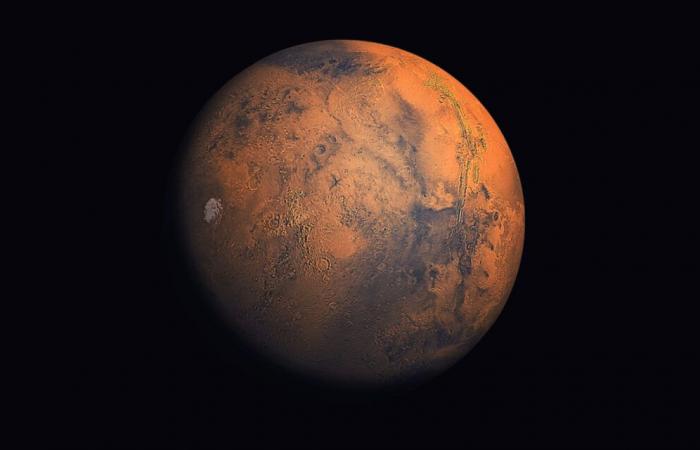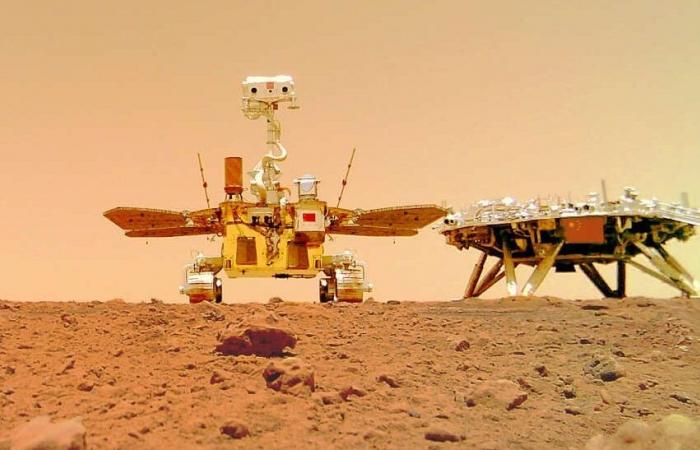A new study published after a successful mission by the Chinese rover Zhurong provides new evidence that reinforces the hypothesis that Mars was once covered by a vast ocean. These discoveries, based on the analysis of geological formations, could shake up our ideas about the Red Planet and its capabilities to support life.
A huge primitive ocean?
Launched in 2021, the Chinese rover Zhurong set down its wheels in the region ofUtopia Plainsin the northern hemisphere. This area was already the subject of speculation regarding the past presence of water. The rover's mission was therefore to confirm these suspicions by providing concrete evidence. It is now done (or almost). Recent discoveries indeed suggest the existence of a primitive ocean on Mars.
In detail, the rover spotted several intriguing geological features. These formations are reminiscent of structures one might expect around Earth's coastlines, such as sunken cones, polygonal troughs, and etched flows.
The former are structures formed by the accumulation and eruption of mud, often linked to underground liquids. On Earth, this type of formation is created when subsurface fluids, such as water or gases, escape and push materials such as mud or sediment toward the surface, forming characteristic cones.
Polygonal hollows are polygon-shaped structures often observed in terrain where water or ice has played a major role in shaping the landscape. These shapes are the result of processes such as freezing and thawing where fractures occur in materials due to temperature variation.
Finally, etched flows refer to formations created by the flow of liquids, such as water or mud, which leave a distinctive mark in the ground. On Earth, this type of flow often occurs in rivers or on slopes where surface water moves sediment. These formations have therefore been interpreted as indications of a presence important enough to have shaped the Martian landscape.
300 million years
According to the new study, a vast ocean covered much of Mars ago about 3.7 billion years. This ocean would have been created by a huge flood which would have submerged large areas of the planet. However, after several hundred million years, the ocean would have started to cool and freezearound 3.4 billion years ago, forming distinctive coastlines and coastlines as the water receded. Eventually, this ocean would have disappeared shortly after.
There are several theories as to why this might have happened. One of the main hypotheses is that Mars lost its ability to maintain liquid water on its surface due to the gradual disappearance of its atmosphere. Originally, the planet would have had a thicker atmosphere, capable of retaining heat and maintaining water in a liquid state. However, due to the absence of a protective magnetic field and the extinction of its internal geological activity, this atmosphere would have been eroded by the solar wind over time. As a result, liquid water would have disappeared, giving way to an increasingly cold and dry climate where the remaining water gradually evaporated or froze.
Note that although these discoveries are exciting, they do not yet allow us to definitively conclude that an ocean actually existed on Mars. The team of researchers, while being enthusiastic, recognizes that further investigations will be necessary to confirm these hypotheses. A mission to bring Martian samples back to Earth could, for example, provide the irrefutable evidence necessary for this conclusion.
A chance of a past life?
The question underlying this research goes well beyond simple geological aspects. If Mars ever had an ocean, it could mean that the planet had conditions suitable for life. Indeed, on Earth, life appeared in aquatic environments, often in primordial oceans where gases and minerals combined to give rise to the first life forms. If Mars experienced a similar period, this could therefore increase the chances that it hosted life or at least favorable conditions for its birth.
Some scientists, like Benjamin Cardenas of Pennsylvania State University, express reservations, however. He believes that elements such as Martian wind could have eroded or modified geological formations over billions of years, which could complicate the interpretation of the data. Although these criticisms are important, they do not challenge the hypothesis of a Martian ocean, but rather highlight the complexity of analyzing ancient geological evidence.







